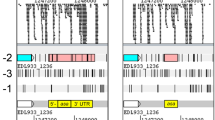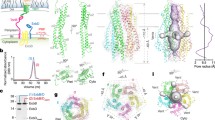Abstract
The gram-negative bacteriumSalmonella typhimurium possesses three distinct Mg2+ transport systems, encoded by thecorA, mgtA, andmgtB loci. The CorA transport system is the constitutive Mg2+ influx system. It can also mediate Mg2+ efflux at very high extracellular Mg2+ concentrations. In contrast, the MgtA and MgtB Mg2+ transport systems are normally expressed only at low extracellular Mg2+ concentrations. A strain ofS. typhimurium was constructed by mutagenesis which lacks Mg2+ transport and requires 100mM Mg2+ for growth. Using this strain, both the MgtA and MgtB transport systems were cloned by complementation of the strains inability to grow without Mg2+ supplementation. After sequencing and further genetic analysis, the MgtB system appears to be an operon composed of themgtC andmgtB genes (5′ to 3′). The downstreammgtB gene encodes the 102 kDa MgtB protein which by sequence analysis is clearly a P-type ATPase. Interestingly, while MgtB has relatively poor homology to other known prokaryotic P-type ATPases, it is highly homologous to mammalian reticular Ca2+-ATPases. MgtC is a 22.5 kDa hydrophobic membrane protein that lacks homology to any known protein. Transposon insertions in this gene abolish uptake by the MgtB transport system. We hypothesize that MgtC is a subunit of the MgtB ATPase involved either in proper insertion of MgtB into the membrane or possibly in binding of extracellular Mg2+ for delivery to the ATPase subunit. The sequence of the MgtA gene has recently been completed, and it too is a P-type ATPase more similar to eukaryotic than prokaryotic P-type ATPases. Expression of both MgtA and MgtB are highly regulated by the concentration of extracellular Mg2+. Transcription ofmgtB can be increased about 1000 fold by lowering Mg2+ from 1 mM to 1 µM. Likewise, whenmgtB is expressed from a multicopy plasmid, a similar decrease in extracellular Mg2+ greatly increases transport. Under growth conditions of limiting Mg2+, MgtB becomes the dominant Mg2+ influx system inS. typhimurium. Even so, since MgtB (and MgtA) mediate only influx of Mg2+, it is unclear why the cell requires energy from ATP to mediate Mg2+ entry into the cell down a large electrochemical gradient. Further studies of the structure-function and energetics of these novel Mg2+ influx P-type ATPases should yield insights into the function of P-type ATPases in general as well as information about the regulation of cellular Mg2+ fluxes.
Similar content being viewed by others
References
Grubbs, R. D., and M. E. Maguire (1987). “Magnesium as a regulatory cation: Criteria and evaluation,”Magnesium 6, 113–127.
Maguire, M. E. (1990). “Magnesium, a regulated and regulatory cation,”Metal Ions Biol. 26, 135–153.
Flatman, P. W. (1991). “Mechanisms of magnesium transport,”Annu. Rev. Physiol. 53, 259–271.
Murphy, E., C. C. Freudenrich, and M. Lieberman (1991). “Cellular magnesium and Na/Mg exchange in heart cells,”Annu. Rev. Physiol. 53, 273–287.
Matsuda, H. (1991). “Magnesium gating of the inwardly rectifying K+ channel,”Annu. Rev. Physiol. 53, 289–298.
Agus, Z. S., and M. Morad (1991). “Modulation of cardiac ion channels by magnesium,”Annu. Rev. Physiol. 53, 299–307.
Hmiel, S. P., M. D. Snavely, J. B. Florer, M. E. Maguire, and C. G. Miller (1989). “Magnesium transport inSalmonella typhimurium: Genetic characterization and cloning of three magnesium transport loci,”J. Bacteriol. 171, 4742–4751.
Snavely, M. D., J. B. Florer, C. G. Miller, and M. E. Maguire (1989). “Magnesium transport inSalmonella typhimurium:28Mg2+ transport by the CorA, MgtA, and MgtB system,”J. Bacteriol. 171, 4761–4766.
Hmiel, S. P., M. D. Snavely, C. G. Miller, and M. E. Maguire (1986). “Magnesium transport inSalmonella typhimurium: Characterization of magnesium influx and cloning of a transport gene,”J. Bacteriol. 168, 1444–1450.
Snavely, M. D., S. A. Gravina, T. T. Cheung, C. G. Miller, and M. E. Maguire (1991). “Magnesium transport inSalmonella typhimurium: Regulation ofmgtA andmgtB expression,”J. Biol. Chem. 266, 824–829.
Snavely, M. D., C. G. Miller, and M. E. Maguire (1991). “ThemgtB Mg2+ transport locus ofSalmonella typhimurium encodes a P-type ATPase,”J. Biol. Chem. 266, 815–823.
Gibson, M. M., D. A. Bagga, C. G. Miller, and M. E. Maguire (1991). “Magnesium transport inSalmonella typhimurium: The influence of new mutations conferring Co2+ resistance on the CorA Mg2+ transport system,”Mol. Microbiol. 5, 2753–2762.
Snavely, M. D., J. B. Florer, C. G. Miller, and M. E. Maguire (1989). “Magnesium transport inSalmonella typhimurium: Expression of cloned genes for three distinct Mg2+ transport systems,”J. Bacteriol. 171, 4752–4760.
Bryson, M. F., and H. L. Drake (1988). “Energy-dependent transport of nickel byClostridium pasteurianum,”J. Bacteriol. 170, 234–238.
Silver, S., and J. E. Lusk (1987). “Bacterial magnesium, manganese, and zinc transport,” inIon Transport in Prokaryotes (B. P. Rosen and S. Silver, eds.), Academic Press, San Diego, California, pp. 165–180.
Lundie, L. L., Jr., H. Yang, J. K. Heinonen, S. I. Dean, and H. L. Drake (1988). “Energy-dependent, high-affinity transport of nickel by the acetogenClostridium thermoaceticum,”J. Bacteriol. 170, 5705–5708.
Jarrell, K. F., and G. D. Sprott (1982). “Nickel Transport inMethanobacterium bryantii,”J. Bacteriol. 151, 1195–1203.
Fu, C., and R. J. Maier (1991). “Identification of a locus within the hydrogenase gene cluster involved in intracellular nickel metabolism inBradyrhizobium japonicum,”Appl. Environ. Microbiol. 57, 3502–3510.
Pedersen, P. L., and E. Carafoli (1987). “Ion-motive ATPases. I. Ubiquity, properties, and significance to cell function,”Trends Biochem. Sci. 12, 146–150.
Nucifora, G., L. Chu, T. K. Misra, and S. Silver (1989). “Cadmium resistance fromStaphylococcus aureus plasmid p1258cadA gene results from a cadmium-efflux ATPase,”Proc. Natl. Acad. Sci. USA 86, 3544–3548.
Hesse, J. E., L. Wiecozorek, K. Altendorf, A. S. Reicin, E. Dorus, and W. Epstein (1984). “Sequence homology between two membrane transport ATPases, the Kdp-ATPase ofEscherichia coli and the Ca2+-ATPase of sarcoplasmic reticulum,”Proc. Natl. Acad. Sci. USA 81, 4746–4750.
Solioz, M., S. Mathews, and P. Forst (1987). “Cloning of the K+-ATPase ofStreptococcus faecalis. Structural and evolutionary implications of its homology to the KdpB protein ofEscherichia coli,”J. Biol. Chem. 262, 7358–7362.
Epstein, W. (1990). “Bacterial transport ATPases,” inThe Bacteria, Vol XII:Bacterial Energetics, (T. A. Krulwich ed.), Academic Press, New York, pp. 87–110.
Dosch, D. C., G. L. Helmer, S. H. Sutton, F. F. Salvacion, and W. Epstein (1991). “Genetic analysis of potassium transport loci inEscherichia coli: Evidence for three constitutive systems mediating uptake of potassium,”J. Bacteriol. 173, 687–696.
Burk, S. E., J. Lytton, D. H. MacLennan, and G. E. Shull (1989). “cDNA cloning, functional expression, and mRNA tissue distribution of a third organellar Ca2+ pump,”J. Biol. Chem. 264, 18561–18568.
Brandl, C. J., S. de Leon, D. R. Martin, and D. H. MacLennan (1987). “Adult forms of the Ca2+ ATPase of sarcoplasmic reticulum: Expression in developing skeletal muscle,”J. Biol. Chem. 262, 3768–3774.
Brandl, C. J., N. M. Green, B. Korczak, and D. H. MacLennan (1986). “Two Ca2+ ATPase genes: Homologies and mechanistic implications of deduced amino acid sequences,”Cell 44, 597–607.
Serrano R., C. Kielland-Brandt, and G. R. Fink (1986). “Yeast plasma membrane ATPase is essential for growth and has homology with (Na+, K+), K+-, and Ca2+-ATPases,”Nature (London)319, 689–693.
Schlesser, A., S. Ulaszewaski, M. Ghislain, and A. Goffeau (1988). “A second transport ATPase gene inSaccharomyces cerevisiae,”J. Biol. Chem. 263, 19480–19487.
Lane, L. K., M. M. Shull, K. R. Whitmer, and J. B. Lingrel (1989). “Characterization of two genes for the human Na,K-ATPase β subunit,”Genomics 5, 445–453.
Salon, J., N. Cortas, and I. S. Edelman (1989). “Isoforms of Na,K-ATPase inArtemia saline: I. Detection by FITC binding and time course,”J. Membr. Biol. 108, 177–186.
Shull, G. E., and J. B. Lingrel (1986). “Molecular cloning of the rat stomach (H+, K+)-ATPase,J. Biol. Chem. 261, 16788–16791.
Verma, A. K., A. G. Filoteo, D. R. Stanford, E. D. Wieben, J. T. Penniston, E. E. Strehler-Page, P. James, T. Vorherr, J. Krebs, and E. Carafoli (1988). “Complete primary structure of a human plasma membrane Ca2+ pump,”J. Biol. Chem. 263, 14152–14159.
Shull, G. E., and J. Greeb (1988). “Molecular cloning of two isoforms of the plasma membrane Ca2+-transporting ATPase from rat brain. Structural and functional domains exhibit similarly to Na+, K+- and other cation transport ATPases,”J. Biol. Chem. 263, 8646–8657.
Feng, D., and R. F. Doolittle (1987). “Progressive multiple sequence alignment,”J. Mol. Evol. 25, 351–360.
Serrano, R. (1988). “Structure and function of proton-translocating ATPase in plasma membranes of plants and fungi.”Biochim. Biophys. Acta 947, 1–28.
Clarke, D. M., T. W. Loo, G. Inesi, and D. H. MacLennan (1989). “Location of high-affinity Ca2+-binding sites within the predicted transmembrane domain of the sarcoplasmic reticulum Ca2+-ATPase,”Nature (London)339, 476–478.
Geering, K., I. Theulaz, F. Verrey, M. T. Häuptle, and B. C. Rossier (1989). “A role for the β-subunit in the expression of functional Na+-K+-ATPase inXenopus oocytes,”Am. J. Physiol. 257, C851-C858.
McDonough, A. A., K. Geering, and R. A. Farley (1990). “The sodium pump needs itsbeta subunit,”FASEB J. 4, 1598–1605.
Noguchi, S., K. Higashi, and M. Kawamura (1990). “A possible role of the β-subunit of (Na,K)-ATPase in facilitating correct assembly of the α-subunit into the membrane,”J. Biol. Chem. 265, 15991–15995.
Geering, K. (1991). “The functional role of the β-subunit in the maturation and intracellular transport of Na,K-ATPase,”FEBS Lett. 285, 189–193.
Zhang, Y. B., and J. K. Broome-Smith (1990). “Correct insertion of a simple eukaryotic plasma-membrane protein into the cytoplasmic membrane ofEscherichia coli,”Gene 96, 51–57.
Pascolini, D., and J. K. Blasie (1988). “Moderate resolution profile structure of the sarcoplasmic reticulum membrane under ‘low’ temperature conditions for the transient trapping of E1 ∼ P,”Biophys. J. 54, 669–678.
Stokes, D. L., and N. M. Green (1990). “Three-dimensional crystals of CaATPase from sarcoplasmic reticulum. Symmetry and molecular packing,”Biophys. J. 57, 1–14.
Stokes, D. L., and N. M. Green (1990). “Structure of CaATPase: Electron microscopy of frozen-hydrated crystals at 6Å resolution in projection,”J. Mol. Biol. 213, 529–538.
Asturias, F. J., and J. K. Blasie (1991). “Location of high-affinity metal binding sites in the profile structure of the Ca2+-ATPase in the sarcoplasmic reticulum by resonance x-ray diffraction,”Biophys. J. 59, 488–502.
MacLennan, D. H., C. J. Brandl, B. Korcak, and N. M. Green (1985). “Amino acid sequence of a Ca2+ + Mg2+-dependent ATPase from rabbit muscle sarcoplasmic reticulum, deduced from its complementary DNA sequence,”Nature (London)316, 696–700.
Greeb, J., and G. E. Shull (1989). “Molecular cloning of a third isoform of the calmodulin-sensitive plasma membrane Ca2+-transporting ATPase that is expressed predominantly in brain and skeletal muscle,”J. Biol. Chem. 264, 18569–18576.
Magyar, A., and A. Váradi (1990). “Molecular cloning and chromosomal localization of a sarco/endoplasmic reticulum-type Ca2+-ATPase ofDrosophila melanogaster,”Biochem. Biophys. Res. Commun. 173, 872–877.
Palmero, I., and L. Sastre (1989). “Complementary DNA cloning of a protein highly homologous to mammalian sarcoplasmic reticulum Ca-ATPase from the crustaceanArtemia,”J. Mol. Biol. 210, 737–748.
Rudolph, H. K., A. Antebi, G. R. Fink, C. M. Buckley, T. E. Dorman, J. LeVitre, L. S. Davidow, J. Mao, and D. T. Moir (1989). “The yeast secretory pathway is perturbed by mutations in PMR1, a member of a Ca2+ ATPase family,”Cell 58, 133–145.
Monk, B. C., M. B. Kurtz, J. A. Marrinan, and D. S. Perlin (1991). “Cloning and characterization of the plasma membrane H+-ATPase fromCandida albicans,”J. Bacteriol. 173, 6826–6836.
Ghislain, M., A. Schlesser, and A. Goffeau (1987). “Mutation of a conserved glycine residue modifies the vandate sensitivity of the plasma membrane H+-ATPase fromSchizosaccharomyces pombe,”J. Biol. Chem. 262, 17549–17555.
Addison, R. (1986). “Primary structure of theNeuropora plasma membrane H+-ATPase deduced from the gene sequence,”J. Biol. Chem. 261, 14896–14901.
Hager, K. M., S. M. Mandala, J. W. Davenport, D. W. Speicher, E. J. Benz, Jr., and C. W. Slayman (1986). “Amino acid sequence of the plasma membrane ATPase ofNeurospora crassa: deduction from the genomic andcDNA sequences,”Proc. Natl. Acad. Sci. USA 83, 7693–7697.
Meade, J. C., K. M. Hudson, S. L. Stringer, and J. R. Stringer (1989). “A tandem pair ofLeishmania donovani cation-transporting ATPase genes encode isoforms that are differentially expressed,”Mol. Biochem. Parasitol. 33, 81–92.
Meade, J. C., J. Shaw, S. Lemaster, G. Gallagher, and J. R. Stringer (1987). “Structure and expression of a tandem gene pair inLeishmania donovani that encodes a protein structurally homologous to eucaryotic cation-transporting ATPases,”Mol. Cell. Biol. 7, 3937–3946.
Author information
Authors and Affiliations
Rights and permissions
About this article
Cite this article
Maguire, M.E. MgtA and MgtB: Prokaryotic P-type ATPases that mediate Mg2+ influx. J Bioenerg Biomembr 24, 319–328 (1992). https://doi.org/10.1007/BF00768852
Received:
Accepted:
Issue Date:
DOI: https://doi.org/10.1007/BF00768852




